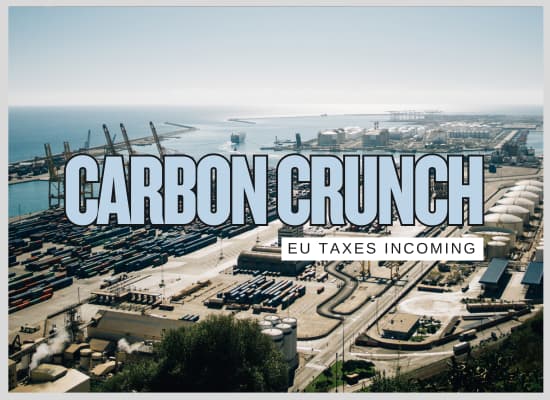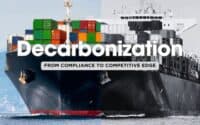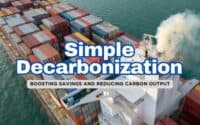Carbon Tax in Shipping: What Every Shipowner Needs to Know in 2025

Whether you're a shipowner, fleet operator, technical manager, or maritime investor, understanding the cost and compliance impact of carbon taxes in 2025 is no longer optional — it's essential.
With the EU Emissions Trading System (EU ETS) now extended to maritime transport, and global discussions around IMO-led carbon pricing gaining momentum, emissions are no longer just an environmental concern — they’re a line item on your balance sheet. From increased voyage costs to reconfigured shipping routes, carbon pricing mechanisms are already influencing how vessels are financed, operated, and chartered.
In this report, we break down what’s happening, who’s affected, and how shipping companies can adapt — or risk falling behind. Whether you manage a fleet of tankers or invest in maritime infrastructure, this is your go-to reference for navigating the carbon tax era in shipping.
🧮 This report contains Ship Universe calculators

We welcome your feedback, suggestions, corrections, and ideas for enhancements. Please click here to get in touch.
Who Pays and When — Carbon Cost Responsibility Breakdown
One of the most misunderstood aspects of maritime carbon pricing is who actually bears the cost. While carbon taxes and emissions trading schemes target ship emissions, responsibility can shift depending on the charter party, flag state, and even contract clauses. In the case of the EU ETS, shipowners are legally accountable for compliance — but costs are often passed down (or contested) in negotiations with charterers, cargo owners, or logistics partners.
Understanding these dynamics is crucial to avoid disputes, budget shortfalls, or compliance gaps. The table below summarizes how responsibility tends to break down across key operational and commercial models:
- Carbon taxes and ETS schemes are typically based on metric tons of CO₂ emitted per voyage.
- The EU ETS price fluctuates but has ranged from €80–€100 per ton CO₂ in 2024–2025.
- Companies must buy emissions allowances (EUAs) to cover actual or estimated emissions.
- Heavy Fuel Oil (HFO): ~3.114 tons of CO₂
- Marine Diesel (MGO): ~3.206 tons of CO₂
- LNG: ~2.750 tons of CO₂
- Methanol (grey): ~1.375 tons of CO₂
- 2024: 40% of emissions need to be covered
- 2025: 70% of emissions
- 2026 onward: 100% of applicable emissions
- 100% of emissions taxed: If voyage is fully within the EU.
- 50% of emissions taxed: For voyages entering or exiting the EU.
- 0% taxed: If both ports are outside the EU, even if ship transits EU waters.
- Emissions are tracked from berth to berth using voyage reports and MRV data.
- Keep accurate MRV (Monitoring, Reporting & Verification) logs to avoid overpaying or facing fines.
- Use routing and fuel choice optimization tools to minimize taxable emissions per voyage.
- Carbon taxes are directly cutting into voyage margins, especially for fuel-intensive routes.
- Older, less efficient ships face steeper erosion, with some routes becoming economically non-viable under 2025 EU ETS pricing.
- Owners operating spot voyages must adjust rates frequently to avoid underpricing freight.
- Dry Bulk: Highly exposed due to longer voyages and fewer emissions abatement options. Slower steaming helps, but time-sensitive cargo limits flexibility.
- Container: Better positioned to offset via rate structures and scale, but exposed on Europe–Asia legs.
- RoRo / Short Sea: Disproportionately hit due to high fuel usage and limited pricing flexibility for small shipments.
- Ship financing models are adjusting for higher OPEX due to carbon costs — tightening loan terms for high-emission vessels.
- Some insurers are starting to review emissions intensity when underwriting operating risk.
- Charterers are also favoring vessels with lower emissions profiles to reduce their own exposure.
- Carbon pricing is no longer just a regulatory issue — it's an operational and commercial differentiator.
- Tracking true cost-per-ton-mile (including carbon impact) is now essential to defend margins and remain competitive.
🧮 Estimated Annual Carbon Tax per Vessel Type (2025)
This tool estimates your annual CO₂ emissions and EU ETS cost based on vessel type, voyage frequency, and fuel choice. All calculations are based on 2025 EU ETS pricing (~€90–100/ton CO₂) and verified emission factors.
ShipUniverse: Estimated Annual Carbon Tax (EU ETS, 2025)
| Select Vessel Type: | |
| Number of Annual Voyages Into or Out of EU Ports: | |
| Fuel Type Used: | |
| 🌍 Estimated CO₂ Emissions & ETS Cost: - | |
| Based on an EU ETS price of €95/ton CO₂. Actual tax may vary depending on voyage profile and market fluctuations. | |
📊 Carbon Tax Impact by Vessel Type (2025)
Not all ships are hit equally by carbon pricing. Emissions vary widely based on vessel type, voyage length, engine configuration, and fuel efficiency. This makes some ships far more exposed than others — especially in long-haul or fuel-heavy segments.
The table below provides a comparative snapshot of how different vessel types are impacted under the EU ETS, assuming typical operations in or near regulated zones. Use this as a starting point for evaluating your fleet's exposure and identifying opportunities for operational or technical upgrades.
- Without a clear ETS clause in the charter party, shipowners may be left covering carbon costs themselves.
- Use BIMCO's recommended “ETS – Emission Trading Scheme Allowances Clause” to allocate responsibility.
- EU and IMO frameworks require strict Monitoring, Reporting & Verification (MRV).
- Errors can lead to fines, rejection of emissions reports, or loss of compliance certificates.
- Allowance prices are volatile — buying late can cost significantly more.
- Some owners have already lost margin by waiting until Q1 2025 to secure 2024 allowances.
- Legacy routing software doesn’t account for carbon cost optimization.
- Modern tools factor in CO₂ intensity and EU port exposure — reducing unnecessary tax exposure.
- Focus on the EU ETS blindsides some operators from upcoming UK, China, and IMO policies.
- Early preparation for global frameworks will reduce future compliance shocks.
- Assign a dedicated compliance officer or team to track carbon-related obligations.
- Audit your MRV data quarterly, not annually, to catch discrepancies early.
Carbon taxes are no longer a future consideration — they’re already cutting into margins. To stay competitive, shipowners must shift from reactive compliance to proactive strategy. That means evaluating not just carbon costs, but how to reduce or control them through smarter operations, technology upgrades, or even contract structuring.
The table below highlights some of the most practical and proven tactics currently being deployed across the industry. Each strategy is weighed by cost, timeline, potential return on investment, and which types of fleets benefit the most — helping you map a response plan that fits your operational and financial reality.
ShipUniverse: Compare Voyage Cost With vs. Without EU ETS
| Select Ship Type: | |
| Select Voyage Length: | |
| Select Fuel Type: | |
| EU ETS Exposure Level: | |
| ⚖️ Fuel-Only vs Fuel+ETS Comparison: - | |
| Based on €95/ton CO₂ (EU ETS, 2025) and 1 EUR = $1.10. Use this to compare EU and non-EU route exposure. | |
📊 Sample Scenarios (Pre-Calculated):
| Ship Type | Voyage | Fuel | Exposure | Total Cost (EUR) |
|---|---|---|---|---|
| Panamax Bulk Carrier | 10 days | HFO | 50% | €96,200 |
| Large RoRo | 3 days | MGO | 100% | €27,900 |
| Feeder Container Ship | 15 days | VLSFO | 100% | €142,200 |
- Shipowners must cover 70% of applicable emissions this year under the EU ETS.
- ETS clauses becoming standard in charter party negotiations.
- All applicable emissions on regulated voyages must be offset with EU Allowances.
- Non-compliance will trigger penalties and potential operating bans in EU ports.
- UK plans to include maritime in its own emissions trading system.
- Expected to mirror EU structure but operate independently.
- IMO member states are debating a universal levy of ~$100–$150 per ton of CO₂.
- Global implementation could begin by 2027 if consensus is reached.
- More nations expected to launch domestic carbon pricing or join multilateral schemes.
- Digital emissions tracking and real-time voyage optimization will become standard tools.
- Owners should plan for both regional and global regimes to overlap — flexibility and digital compliance tools will be critical.
Carbon pricing in shipping is no longer a policy debate — it's an operational reality. From EU port calls to potential global levies, shipowners, operators, and investors must factor carbon into every voyage, every contract, and every long-term decision.
The good news? Strategic adaptation isn’t just about survival — it can also unlock competitive advantages. Fleets that respond early with smart routing, emissions optimization, and low-carbon investments will not only stay compliant — they’ll lead.
Table Summary

Do you have a Maritime Product or Service that may be of interest to Shipowners? Tell us about it here!
Do you have feedback or insights? Please reach out to editor @ shipuniverse.com



